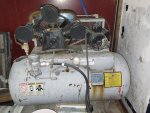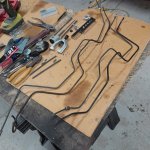A few thoughts, none of this is meant as criticism:
... and won't be taken as such. I am going break it down as it's easier for me to respond that way, I'm not critizing either just continuing the discussion.
Warning, I started chasing a rabbit down a hole, to include some questionable napkin math fueled by googlefu.
First, don’t put a higher pressure limit relief valve on it. Never in your wildest dreams do you want to put an increased pressure relief valve on anything. If you think PVC pipe is exciting when it explodes, go online and look at ruptured air tanks. They’ll take the building down at the same time they take your head off.
The original form of my compressor was 60 Gal 3.5 HP single piston pump rated at 130 PSI Max. About the only original pieces left are the pressure vessel (tank), the safety valve, and the pressure guage.
The pressure vessel is actually rated at 150 PSI working pressure, that is from the actual manufacturer of the pressure vessel and a separate label from the "compressor manufacturer" spec label. The 130 PSI max was original pump limit.
The pump was upgraded by the PO to a dual piston rated for a maximum of 145 PSI @ 1050 RPM. At max output, the pump is 5 PSI shy of tank working pressure. Pump is still brand new, he gave up on it when his motor failed. I'm powering the pump with the recommended 5 HP motor which turns 3450 RPM. Due to available pulley sizes the pump will only spin at about 1011 RPM, which should put the actual max pressure a little shy of the rated 145 PSI max.
New control switch was required due to missing parts and not knowing what the PO did to it that killed the motor. New control switch is (supposedly) preset at 105 PSI cut in and 135 PSI cut out. As preset, it'll kick off before the the pump reaches it's max output, and about 15 PSI before tank reaches rated working pressure.
Original safety valve appears to be set at 130 PSI to match the original pump's max pressure. I am suggesting to install a 140 PSI safety valve which is still likely under the new pump's potential max pressure, and about 10 PSI below the tank's rated working pressure.
I have been taking pressure ratings into account when thinking about all of this.
As regards to copper, I considered that, and I just looked, but I can’t find it right now, but I saw something where the solder joints on copper are actually weaker than the PVC pipe. When you glue the PVC pipe, it’s basically all one solid piece of plastic. With enough pressure, the sweat joints can pop loose. Didn’t make sense to me when I read it, but I did read it. Point being, be careful.
That is another reason I'm likely to go steel over copper. I have very little experience sweat soldering a copper joint. It would be an opportunity to learn, but threaded iron connections would be more durable and likely easier for me to make a good seal. I'm not just talking about burst pressure durability. I'm also thinking about moving things around in the shop and causing physical damage to the pipe. Things that would crush copper pipe will bounce off of iron pipe.
And then let me say, I always used to run my air systems at home at 100 or 120 psi. Then I had an epiphany about a dozen years ago, that I never really need air over about 50 or 60 psi for the stuff I’m doing. if you use a strong air impact wrench, that takes some pressure. But for 90% of the stuff, why would you need that much air pressure? Just trying to help you think it out
For general work I run air tool at 100 PSI. I run air tools on 100 PSI all day every day at work for over 18 years. It works 90% of the time and I don't see any reason to mix up the formula at home. That said there are a few times where having more available could be beneficial.
Here's the thing I'm more interested in, bear with me because I might be doing a poor job of explaining my point. I might operate tools at 100 PSI or less more than 90% of the time, but tank pressure also affects working and cycle time. A 60 Gallon tank at 135 PSI is going to output that 100 PSI a fair bit longer than the same 60 gallon tank at say 110 PSI. That 25 PSI change is about another 14 cubic foot of air volume in the tank, which means the tank outputs longer before the pump has to cut on and would be an even more noticable difference at lower operating pressures. Also more CF of air in the tank = more tires inflated before pump kicks back on. To put that in terms of your favorite tire size (the 14s you've been collecting), it would fill an additional 3 tires to from empty to 35 PSI before the compressor kicks on.
Another way of thinking about it. If I'm running a tool at 100 PSI. If the compressor is set to kick on at 90 and off at 120 (where dad wants to run it), then the pressure at the tool is going to drop before the pump kicks on. If the switch is set at 105 and 135, the compressor will kick on, fill up, and kick off before a pressure drop is noticed at the tool. Might not ever matter much in practice, but I can tell you that it was always annoying loosing even a little air pressure at work.
Finally, compressed air costs a lot of money in electricity. If you run half the pressure, it doesn’t cut the electric bill by half, it cuts it by the square root.
Nothing critical, not ever, just food for thought. Hope it helps.
Electricity use when running a compressor is one thing I am NOT concerned about. It likely won't make a noticable impact on my bill because if I'm using it I'm not using other power hungry devices I'd be using instead, and electricity here is relatively cheap compared to other areas around me.
I warned you, chasing a rabbit down a hole. Wondering when Morpheus is going to appear and offer me a red or blue pill. Right now if the blue pill helped me sleep, I might take it.















